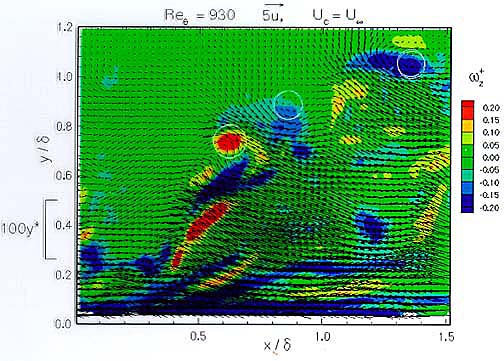Assistant Professor of Mechanical and Environmental Engineering
![]()
Wall Turbulence:
This research is to examine the physics of turbulence near rigid boundaries. Specifically, we examine the instantaneous structure of turbulent boundary layers by analysis of velocity vector maps obtained experimentally, using Particle Image Velocimetry (PIV). Results of this research provide a better understanding of how momentum is transported throughout the boundary layer. It also forms a basis for new models of coherent structures in the boundary layer.
In this research Particle Image Velocimetry (PIV) is used to measure between 10,000 and 25,000 velocity vectors over a 2-D plane of a turbulent boundary layer at a single instant in time.

Instantaneous realization of a turbulent boundary layer.
The vectors indicate the instantaneous velocity field when viewed in a frame-of-reference convecting with the free-stream velocity. The color contours indicate the magnitude of spanwise vorticity. The vortices indicated by dark red and blue color are responsible for transporting momentum in the boundary layer. These vortices are associated with Reynolds stress producing events.

Intense Reynolds stress producing regions are indicated by the dark-red color contours. These regions are closely associated with vortices (indicated by white circles).
Acknowledgement:
This work was initially conducted at the laboratory for Turbulence & Complex Flow [http://hairpin.tam.uiuc.edu]. at the University of Illinois, and in collaboration with Prof. Ronald J. Adrian [http://www.tam.uiuc.edu:80/Faculty/Adrian.html].
Research Publications Instruction Students

Contact bennett@engineering.ucsb.edu with comments or questions.
Last Modified: June 3, 1997 - M. Jordan